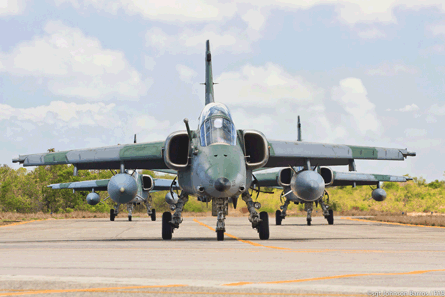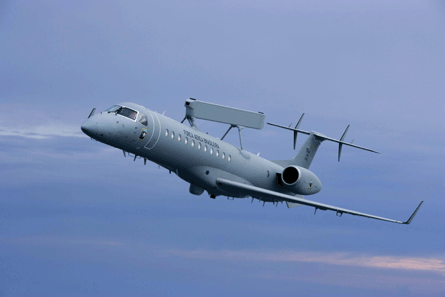Judging by the standard of most Portuguese-language internet reviews, last year's Brazilian-made blockbuster Segurança Nacional was a total flop.
Apparently, a film based on the 2002 deployment of the Raytheon-built Amazon surveillance system (SIVAM), with ample aerial footage of Embraer-made fighters and surveillance aircraft, and plot twists involving a nuclear bomb in the hands of Mexican drug cartels, does not resonate with Brazilian audiences. However it is important - for Embraer's sake - that Segurança Nacional was well received by the ministry of defence, which financed the production of the Hollywood-style film.
Although dismissed by one anonymous online reviewer as "more propaganda than a military action movie", the script no doubt expresses exactly how Brazil's rising military views its emerging role on a typically peaceful continent. Backed by intelligence provided by a powerful surveillance network and muscle from the Embraer A-26 Super Tucano, the film portrays Brazil air force and intelligence services leading a Latin American offensive on drug traffickers doubling as marauding terrorists.
 |
|---|
© USAFA Brazilian Aermacchi/Embraer A-1 leads a formation comprising US F-16, French Rafale and Mirage, and Chilean F-16 fighters |
If this is truly the vision of the Brazilian military, it will need more than SIVAM, the Super Tucano and Embraer's P-99 and R-99 surveillance aircraft.
The country's armed forces and national police also require land and maritime surveillance and communications networks as extensive as the aerial net over the immense Amazon region already provided by SIVAM.
They will need terrestrial radar networks, satellite surveillance and communications relay and sophisticated command and control systems tying all of them together.
It may be a curious development for a country that has not fought a major war on its own continent in more than 140 years, but Brazil's place in the world is changing.
With rich oil deposits recently discovered in the pre-salt layer off Brazil's coastline and the country serving as host for two global events - the football World Cup in 2014 and the Olympics in 2016 - Brazil's security forces are rapidly preparing for a more visible role in regional and world affairs. As Brazil's military eyes a larger role, so is local industry - led by Latin America's heavyweight Embraer. In December, the aerospace company made its defence business an autonomous subsidiary - Embraer Defense Systems.
"Having in mind our long-term vision for this business, we created and separated a corporate unit to handle the defence business and expanded not only in terms of size but also in terms of broadness of our activity," says Frederico Curado, Embraer chief executive.
|
|---|
© EmbraerThe P-99 is adapted from the ERJ-145 |
"Not only [with] the air force, but also [to] start looking into opportunities with the army, with [the] navy, with homeland security types of applications," he adds. "So we see there is growth there, and we want to address that growth in a very dedicated and specific manner."
In some ways, launching a standalone business, which opens with roughly $850 million in projected annual revenue and a $3 billion sales backlog, is a return to form for Embraer.
Now recognised globally as the maker of commercial regional jets, the company owes its foundation to the Brazilian air force.
Air Marshal Casimiro Montenegro Filho founded the Institute of Aeronautical Technology (ITA) in 1950, modelling the engineering school on the Massachusetts Institute of Technology. The General Command for Aerospace Technology (CTA) quickly emerged from the ITA, supporting the air force with trained aeronautical engineers.
The CTA designed and developed the twin-engined Bandeirante in 1968, then formed a state-owned company - Empresa Brasileira de aeronáutica (Embraer) - to market the aircraft commercially. As Embraer's regional jet business gathered momentum after the early 1990s, the company stayed connected to its defence business and its original customer - the Brazilian air force. The result is the portfolio that now largely forms the basis of the defence company's sales backlog today. The Super Tucano was introduced in the domestic and export market in 2003 and is now a candidate for a US Air Force contract for a light air support fighter/trainer to be awarded in June.
The P-99 and R-99 surveillance aircraft adapted from the ERJ-145 regional jet have four customers with 15 airframes already in service.
The Brazilian military has also provided a steady flow of modernisation contracts to Embraer, with work ongoing to upgrade 12 navy A-4s and 57 air force F-5Ms. The air force also awarded Embraer a contract in January to overhaul the structures of 43 A-1M light attack jets, although government funding cutbacks have postponed much of the work.
 |
|---|
© USAFThe Super Tucano was introduced in the domestic and export market in 2003 |
The air force then teamed with Embraer in 2009 to develop the KC-390 tanker-transport, marking the first launch of an all-new aircraft in support of the air force since the EMB-312 Tucano started taking shape in the late 1970s.
The KC-390 should dominate revenues and sales into the next decade but Embraer has set its own sights even higher for the defence business. Embraer's new defence business now aims to take on the role of a large-scale systems integrator, a role already embraced by Embraer's competitors in Europe and the USA. The Brazilian manufacturer started dabbling in the integrator market a decade ago.
In 2001, Mexico ordered three surveillance versions of the ERJ-145 along with a command and control centre for tracking drug traffickers. Embraer also played a large role with Raytheon in the establishment of the SIVAM aerial surveillance network, and now plays a major role in its operation.
To supplement this experience, Embraer's defence unit is also developing expertise through acquisition.
On 15 March, the company announced the acquisition of a majority stake in OrbiSat da Amazonia, with Embraer taking control of the division that develops sensors for air, land and sea applications.
Meanwhile, Brazil's military leadership is developing plans to dramatically expand the surveillance capability acquired with SIVAM. According to Bengt Janer, Saab's Gripen programme director in Brazil, the senior defence officials are discussing concepts for land and maritime surveillance networks covering the Amazon region as well as the deep ocean.
Rather than allow a foreign company to assume the lead role in these future contracts, as Raytheon captured the SIVAM contract over a French competitor in 1994, Embraer wants to take that position as an indigenous company.
 |
|---|
© FABEmbraer has won a contract for structural overhaul of 43 A-1M light attack jets |
The only question now is whether Brazil's population can accept the investment required to dramatically expand the capabilities on display in Segurança Nacional.
Until recently, it appeared that Brazil's roaring economy could offset any serious concern about plans to nearly triple defence spending from an estimated $23.2 billion in 2008 to nearly $65.7 billion in 2015, according to the April 2011 Brazil Defence & Security Report by Business Monitor International.
However, concerns about over-heating inflation rates have forced government officials to a 26.5% cut to the military's procurement budget this year. How that will effect Embraer's growth strategy for the new standalone business is still unclear.
Eduardo Bonini, chief operating officer of Embraer Defense Systems, was asked in February how much the new company could grow in the next five years from its 2011 baseline of $850 million. Bonini hedged a little, but acknowledged a goal to become a $1 billion business in that timeframe.
By then, perhaps Brazilian audiences will warm to Segurança Nacional: The Sequel.
- View Flightglobal Insight's guide to airborne imaging
Source: Flight International




















